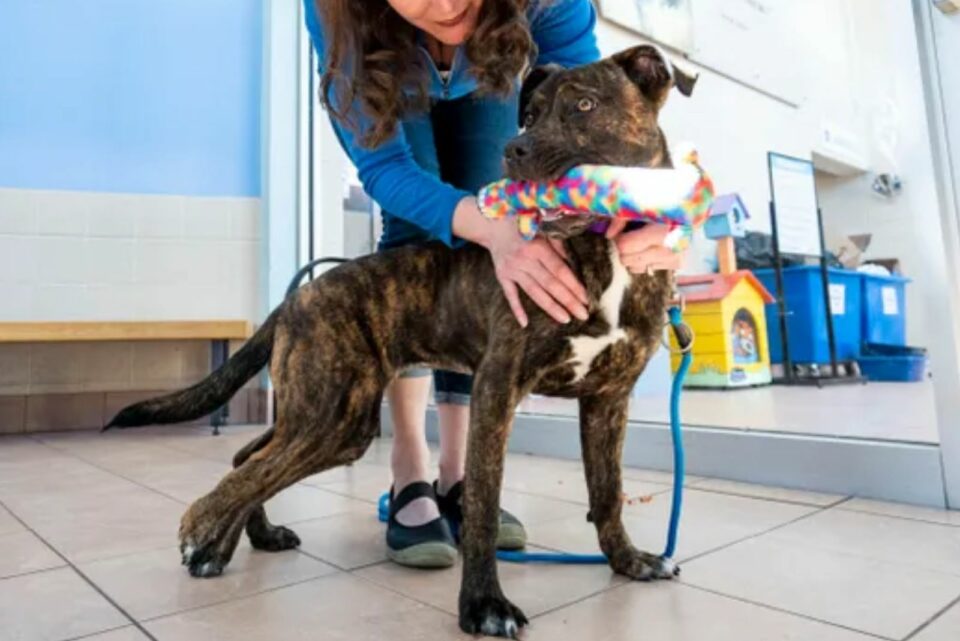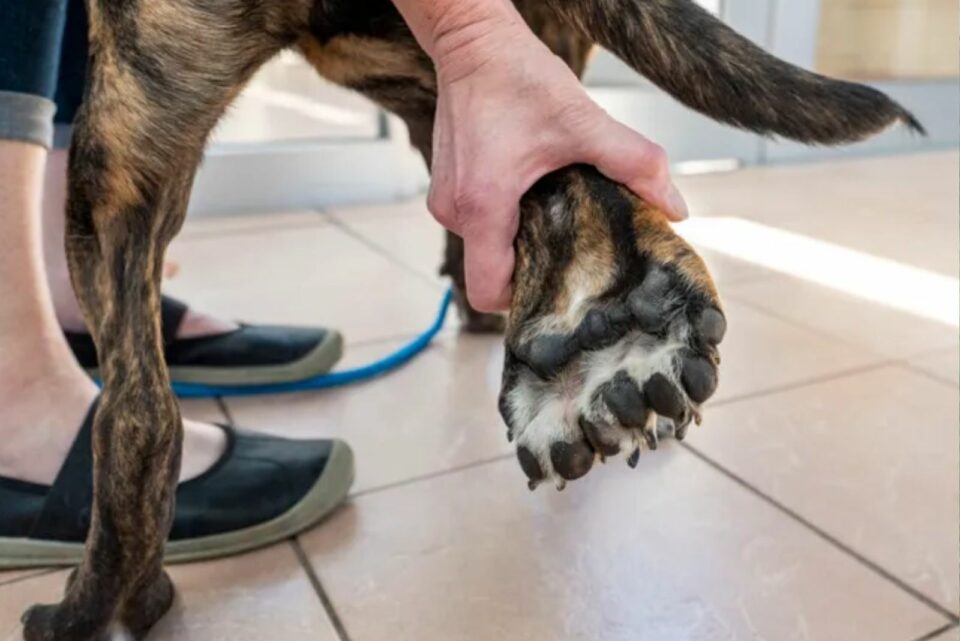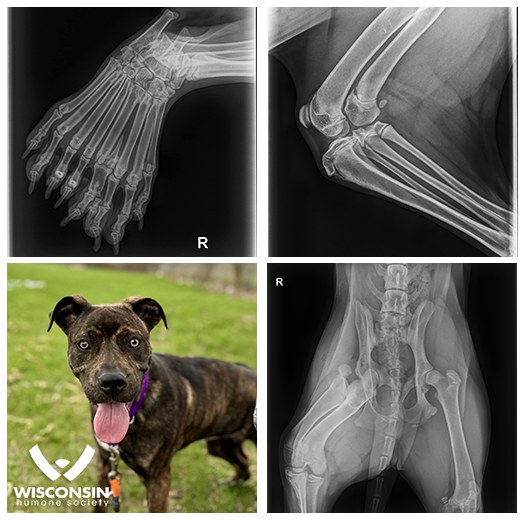In the poker game of life, Bella, the shelter puppy, got some pretty bad cards.
Still, that didn’t stop her from going for the win.
In the long history of one Wisconsin shelter, this pup was the first, maybe even the only one they’d seen with this condition.
It didn’t stop Bella from being pawesome.
It helped her be extra cool.
It gave her the strength to go the extra mile and give an arm and a leg for a potential new family.
She’s Got What?

Dimelia – that’s the name of the condition.
Everyone at the Wisconsin Humane Society was astonished when they saw Bella.
No one at the shelter recalls seeing such a puppy join their society.
A dog with a missing leg or two can be considered common. Accidents happen, and poor breeding practices, too.
But, a dog with five legs? Well, that’s something almost fit for the circus.

When she arrived at the shelter, the vets diagnosed her with the said condition. Dimelia gave Bella extra bones as well as nine toes on one hind leg. That entitles her to be known as the dog with five legs.
“We were all just as floored as you likely are when we saw the X-rays! This 6-month-old puppy has dimelia, an extremely rare congenital anomaly characterized by the duplication of bones. It’s basically like an extra leg inside her right hind leg. A normal canine hind leg would have one femur, one tibia, one fibula, and 4-5 toes,” the organization posted on Facebook.
“X-rays of the affected leg revealed that Bella appears to have an extra femur, two tibias, two fibulas, and nine toes on her rear paw. It is the first-ever case of dimelia we’ve seen in our organization’s history, and as far as we can tell, she’s one of the *very* few documented cases of dimelia in a dog – ever,” they added.

Quite unusual, isn’t it? Well, imagine how Bella, the only known dog so far, feels about it!
Fortunately, for this sweet girl, dimelia doesn’t give her mobility issues.
It appears that if a dog is affected by dimelia, nothing really should be done if the condition doesn’t cause any issues with the dog’s comfort or mobility. However, experts suggest some radical measures, such as amputation, if dimelia is making daily life hard. |1|
Bella doesn’t mind going for walkies at all. She loves it! And, she loves bouncing around, playing, and just being a happy pupper.
Where’s My Furever Hooman?

At the Kenosha Campus where Bella resides, everyone believes she will find a furever home soon.
However, a special dog with a special condition needs someone special, too. No matter how much you love dogs and want to adopt one yourself, you need to know that a dog like Bella needs medical attention.
Bella’s flipper-like hind leg may not cause her trouble now, but it certainly will as she ages. Older dogs often have mobility problems with their joints and worn-out cartilage. Just imagine how a dog with dimelia would feel about running in a few years.
A lot of people have something called the saviour complex, and they’re not even aware of it. Not every dog can be saved. A single person can’t save them all, and we need to understand that.
Sure, Bella is a wonderful dog… no one doubts that. But, you need to be ready for lots of potential medical bills. Owning a dog is not a hobby… it’s a lifetime responsibility.
If you want to get a pup just for fun, and you’re not ready to face situations like lifelong illness, mobility issues, high medical bills, or constant care, please don’t adopt.
The Wisconsin Humane Society has lots of dogs who need help.
If you’re a role model adopter and future dog owner, please consider visiting them.
Bella is looking for her hooman.
Are you the one?
References:
|1| J. Kim , W. E. Blevins , G. J. Breur. Morphological and functional evaluation of a dog with dimelia. 2006. DOI
If you’ve ever found yourself wondering why your furry friend seems to have a particular affinity for showering you with slobbery kisses, you’re not alone. Dog licking is a behavior that’s as common as it is endearing, but have you ever stopped to ponder the reasons behind this wet display of affection? It’s a phenomenon that many pet owners experience daily, leaving them both puzzled and amused by their canine companion’s persistent licking habits. From a quick swipe across your hand to full-on face washes, your dog’s penchant for licking can sometimes feel like a mystery waiting to be unraveled. So, what’s really going on when your four-legged pal can’t seem to resist the urge to give you a lick or two? Let’s take a closer look at this charming yet curious behavior to uncover the potential motivations behind it.
Understanding Your Dog’s Licking Behavior
The Science Behind Licking
Dogs licking you isn’t random; there’s science behind it. Licking releases endorphins, making your dog feel good, like a calming massage. It’s a natural behavior ingrained in them from birth. The action triggers memories of being licked by their mothers as pups, creating a strong bond.
Licking as a Form of Communication
When your dog licks you, it’s their way of communicating. They use it to show affection, respect, or to seek attention from you. It can also be a sign of submission or a request for something, like food or a walk. Understanding the context of the licking can help decipher what your furry friend is trying to tell you.
Common Reasons for Excessive Licking
Seeking Attention and Affection
When your dog licks you a lot, it’s often their way of seeking your attention and showing affection. Dogs are social animals, and they use licking as a form of communication to bond with their human family members. It’s a way for them to interact with you and express their love.
Tasting Salty Skin
Dogs have a strong sense of taste, and they are naturally attracted to the salt on your skin. Your skin tastes different from theirs, and the salty taste can be appealing to them. So, if your dog licks you excessively, they might simply enjoy the taste of your skin.
Indicative of a Health Issue
Excessive licking can sometimes be a sign of an underlying health problem. If your dog suddenly starts licking you more than usual, it could indicate that they are experiencing discomfort or pain. It’s essential to monitor their behavior and consult with a vet if you notice any changes in their licking habits.
Behavioral Factors and Dog Licking
Anxiety and Stress-Related Licking
If your dog’s been licking you more than usual, it could be a sign of anxiety or stress. Dogs may lick excessively when they feel anxious or stressed out. This behavior can sometimes manifest as a coping mechanism for them to calm themselves down. Pay attention to other signs of anxiety in your dog, such as pacing, trembling, or hiding, to determine if stress could be the cause of their increased licking.
Learned Behavior from Owners
Dogs are smart creatures and often learn behaviors from their owners. If you tend to show affection by petting or cuddling your dog when they lick you, they may have learned that licking is a way to get your attention and affection. This learned behavior can lead to excessive licking as they try to seek more attention from you. Consider how you react to your dog’s licking and whether unintentionally encouraging this behavior could be a factor in their increased licking habits.
When to Be Concerned About Your Dog’s Licking
Signs of Obsessive Behavior
If your dog is excessively licking you to the point where it interferes with daily activities or becomes a compulsive habit, it may indicate obsessive behavior. Look for signs like persistent licking for extended periods, causing skin irritation or sores, or neglecting other essential behaviors like eating or playing.
Licking Accompanied by Other Symptoms
Keep an eye out for licking accompanied by other symptoms such as changes in appetite, lethargy, hair loss, or any unusual behavior. When licking is coupled with these signs, it could be a red flag for an underlying health issue that needs veterinary attention.
Remember, while licking is a common behavior in dogs, excessive or abnormal licking patterns warrant your attention, especially when they impact your dog’s well-being. Always observe any changes in your dog’s licking habits and behavior to ensure they are happy and healthy. If you notice concerning signs, seek advice from a veterinarian to address any potential issues promptly.
Reducing Excessive Licking in Dogs
Training and Positive Reinforcement
When addressing excessive licking in your dog, training plays a crucial role. Redirect your dog’s behavior by teaching them alternative actions through positive reinforcement. For instance, offer a chew toy or engage them in a game when they start licking excessively. Reward your dog when they refrain from licking with treats or praise. Consistent training can help in reducing this behavior over time.
Creating a Calming Environment
Creating a peaceful and calming environment for your dog can help minimize excessive licking. Ensure your dog has enough exercise to release pent-up energy and reduce stress levels. Establish a routine that includes regular playtime, walks, and relaxation. Providing designated quiet spaces in your home where your dog can retreat to can also aid in decreasing anxiety-induced licking. Remember, a serene environment can positively impact your dog’s behavior.
Consultation With Veterinary Professionals
When to See a Vet
If your dog’s licking behavior becomes excessive, interferes with daily activities, or leads to skin problems, it’s time to consult a vet. Look out for any changes in appetite, energy levels, or unusual habits paired with relentless licking—it could indicate an underlying health issue that needs professional attention.
Possible Treatments for Excessive Licking
Veterinary professionals may suggest various treatments for your dog’s excessive licking, depending on the underlying cause. Treatment options could include behavioral training, medications, addressing any medical conditions, or implementing environmental changes to reduce stress. Always follow your vet’s guidance to ensure your furry companion receives the best care tailored to their needs.
Conclusion
So, there you have it – your furry friend’s licking habits decoded! Whether it’s a gentle sign of love or a cry for attention, understanding why your dog licks you excessively is key to fostering a healthy and happy bond. Remember, monitoring their behavior and seeking professional advice when needed are essential steps in ensuring your pup’s well-being. With a little training, positive reinforcement, and maybe a visit to the vet, you can help your dog kick the licking habit and lead a balanced life full of tail wags and belly rubs. Keep an eye out for any unusual changes in behavior and remember, a lick or two is cute, but moderation is key!
Frequently Asked Questions
Why do dogs lick their owners?
Dogs lick their owners as a sign of affection, stemming from early interactions with their mothers where licking was a means of bonding and endorphin release.
What are the reasons for excessive licking by dogs?
Excessive licking by dogs can be due to seeking attention, tasting salty skin, or underlying health issues, necessitating accurate interpretation and potential veterinary advice.
How can anxiety and stress contribute to excessive licking in dogs?
Anxiety and stress can lead to excessive licking in dogs, serving as indicators of stress levels and learned behavior from owners, highlighting the importance of behavior monitoring and intervention.
When should I be concerned about my dog’s licking behavior?
Monitoring abnormal licking patterns coupled with changes in appetite, lethargy, or unusual behavior is crucial, as they could signify underlying health problems warranting veterinary attention for the dog’s well-being.
What are recommended strategies for addressing excessive licking in dogs?
Addressing excessive licking in dogs involves training, positive reinforcement, and behavior redirection, such as teaching alternative actions and rewarding non-licking behavior to gradually reduce excessive licking with professional veterinary guidance.
What treatments can be considered for dogs with persistent licking issues?
Possible treatments for dogs with persistent licking issues may include behavioral training, medications, addressing medical conditions, or environmental changes to reduce stress levels, under the guidance of veterinary professionals for individualized care.
[no_toc]

Hey there, I’m Janet Brooks, a dog-loving student from California. I’m all about helping pups in need, especially those without homes. Me and my awesome friends work together to give shelter and love to stray dogs. Oh, and I also write blogs about dogs to share helpful info.